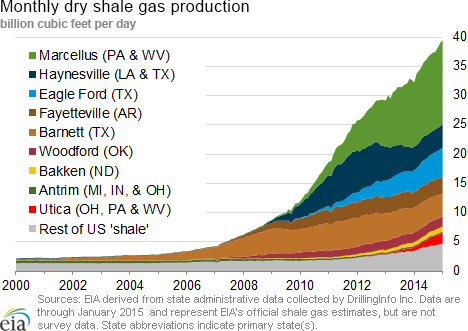In the News:
Power burn reaches record January and February levels, driven by weather and structural change
Power burn, or the use of natural gas for power generation, reached record monthly levels in both January and February, driven by increased consumption in the eastern half of the country. Total power burn for January and February averaged 23.1 billion cubic feet per day (Bcf/d), 3.6 Bcf/d higher than the five-year (2010-14) average for that period, according to data from Bentek Energy . Although colder-than-normal temperatures drove much of this change, power burn has been increasing over the past several winters in certain regions as more gas-fired capacity has been added. Additionally, relatively low natural gas prices have contributed to the displacement of generation by other fuels.
As single-digit temperatures gripped much of the eastern half of the country, new winter or monthly power generation load records were being set. The PJM Interconnection, the country's largest independent system operator, which manages a grid extending into 13 states in the Mid-Atlantic and in the Midwest, set a winter peak demand record on February 20. On that day, demand increased to 143,826 megawatts (MW), besting the previous record of 142,863 MW, set in January 2014. One day earlier, the smaller Tennessee Valley Authority, which spans seven states, broke a February record, when demand reached 694 MW, 9 MW shy of TVA's all-time record high.
Power burn records for January and February were set in regions east of the Rocky Mountains, which experienced colder-than-normal temperatures during those months, while power burn in the West was below its five-year average. Natural gas consumption for electric generation is greatest in the eastern half of the country, which includes the three largest power burn regions, the Southeast, Northeast, and Texas. Power burn in these regions combined was 17.3 Bcf/d for January and February, 3.6 Bcf/d higher than the five-year average and 2.2 Bcf/d higher than their previous peak for that period, set in 2012. Southeast and Texas electricity consumption is more sensitive to winter temperatures than other areas of the country, as more of their heating requirements are satisfied by electricity.
Although the weather drove most of the changes in power burn this year, power burn has been growing over the past several years because of relatively low natural gas prices and an increasing amount of natural gas generation capacity that has come online. Retirements of nuclear and coal capacity have also supported the growth of the share of natural gas in the electric generation fuel mix. For example, Entergy's Vermont Nuclear plant, the fifth-largest source of generation in New England, accounting for 4% of New England's total electric generation, closed at the end of December 2014, and its loss may contribute to higher rates of gas use by the region's natural gas-fired generators.
Overview:
(For the Week Ending Wednesday, March 4, 2015)
- Natural gas price movements were mixed over the report week. The Henry Hub spot price rose 9¢ over the report week, from $3.17/million British thermal units (MMBtu) last Wednesday, February 25, to $3.26/MMBtu on Wednesday, March 4. Prices fell at most market locations in the Rockies and the West Coast.
- At the New York Mercantile Exchange (Nymex), the March contract expired Wednesday, February 25, at $2.894/MMBtu. The April contract moved into the front-month slot and dropped over the week from $2.862/MMBtu last Wednesday to $2.769/MMBtu yesterday.
- Working natural gas in storage decreased to 1,710 Bcf as of Friday, February 27, according to the U.S. Energy Information Administration (EIA) Weekly Natural Gas Storage Report (WNGSR). A net withdrawal from storage of 228 Bcf for the week resulted in storage levels 40.4% above year-ago levels and 7.7% below the five-year average for this week.
- The natural gas rotary rig count continued to decline, falling by 43 rigs from the previous week, according to data released by Baker Hughes Inc. As of February 27, there were 1,267 total rigs operating in the United States. The natural gas rig count fell by 9 to 280, and the oil rig count fell by 33 to 986.
- The natural gas plant liquids composite price increased by 7¢ to $5.94/MMBtu for the week ending February 27. All Mont Belvieu NGL spot prices except propane were up this week. Ethane prices increased 8.2%, and natural gasoline, butane, and isobutane prices increased by between 1.1% and 1.3%. Propane prices declined by 1.6%.
Prices/Demand/Supply:
Rockies are a dividing line for prices. Most natural gas prices in the East, Midwest, and South rose moderately over the week. The Henry Hub spot price rose from $3.17/MMBtu last week to $3.26/MMBtu yesterday. However, midweek, Henry Hub spot prices reached a weekly low on Friday, February 27 of $2.77/MMBtu before bouncing back by the end of the week. Forecasts for cold weather and winter storms on Thursday in the eastern half of the country likely led to the increase in prices. At the Chicago Citygate, the natural gas price rose from $4.62/MMBtu last Wednesday to $4.98/MMBtu yesterday. In the West, however, forecasts called for warmer weather in the coming days. At the Opal Hub in Wyoming, prices fell from $2.96/MMBtu last Wednesday to $2.82/MMBtu yesterday. Similarly, at the PG&E Citygate in San Franciso, prices fell from $3.16/MMBtu last Wednesday to $2.98/MMBtu yesterday.
Prices at major market locations in the Northeast post overall declines, but prices are volatile. At the Algonquin Citygate, which serves Boston consumers, prices declined from $25.42/MMBtu last Wednesday to $7.13 Tuesday, then rose to $13.98/MMBtu on Wednesday on forecasts for cold weather and snow. Similarly, at the Transcontinental Zone 6 trading point for delivery into New York City, prices began the week at $23.68/MMBtu before dropping to a weekly low of $3.45/MMBtu on Friday, then rose to $15.83/MMBtu yesterday.
Marcellus-area prices go lower. At Tennessee's Zone 4 trading region, which represents Marcellus deliveries on Tennessee's pipeline system, prices began the week at $1.50/MMBtu, then bottomed out at 98¢/MMBtu on Friday before ending the week at $1.30 /MMBtu. Prices at Dominion South, which serves customers in portions of Pennsylvania, Ohio, Maryland, West Virginia, and Virginia, increased from $2.87/MMBtu last Wednesday to $3.05/MMBtu yesterday. On Transco's Leidy Line, prices began the week at $1.58/MMBtu, then fell to end the week at $1.38/MMBtu, for an overall loss of 20¢. While Marcellus production remains strong, last week Chesapeake Energy said it would reduce its Marcellus drilling this year because of low prices in the area.
Nymex prices decline. At the Nymex, the April 2015 contract moved into the near-month position on February 26. The March contract expired on February 25 at $2.894/MMBtu, after rising 17.4¢ during its tenure as the near-month contract, but was still relatively low. The April contract declined this week from $2.862/MMBtu last Wednesday to $2.769/MMBtu yesterday. The 12-month strip (the average of the 12 contracts between April 2015 and March 2016) fell from $3.071/MMBtu last Wednesday to $3.009/MMBtu yesterday.
Supply declines. Total natural gas supply declined 1.3% from last week. Dry production declined 0.4% from last week, but is 8.3% greater than the same week last year. Canadian imports declined 5.7% from the previous week, as overall temperatures this week were milder and demand fell. Imports in the Midwest and Northeast declined by 18.3% and 18.2%, respectively, while imports in the West rose by 8.0%. LNG sendout also declined from last week by 41.2%.
Across all sectors, consumption falls. Consumption began the week at relatively high levels but fell as temperatures moderated in the second half of the report week. Total domestic consumption fell 7.3% week over week, and was 0.5% less than the same week last year. Residential and commercial consumption fell 10.9% from last week, with consumption beginning the report week high, then dropping drastically. Consumption of gas for electric power generation fell 3.7%, while industrial consumption declined 1.8%.
Storage
Storage inventories fall further below five-year average. After surpassing their five-year average two weeks ago, natural gas stocks are now below their five-year average following two weeks of larger than average withdrawals. With a net withdrawal of 228 Bcf for the week, working gas inventories as of February 27 totaled 1,710 Bcf, 492 Bcf (40.4%) higher than last year at this time and 143 Bcf (7.7%) lower than the five-year (2010-14) average. The 228-Bcf net withdrawal reported for the week was higher than both the five-year average and last year's net withdrawals for the week ending February 27, which were 115 Bcf and 144 Bcf, respectively.
Storage withdrawals are close to market expectations. Market expectations, on average, called for a pull of 224 Bcf. When the EIA storage report was released at 10:30 a.m. on March 5, the price for the April natural gas futures contract decreased 3¢ to $2.77/MMBtu, in trading on the Nymex. In the next hour, prices increased, trading around $2.82/MMBtu.
The West is still the only region with a surplus compared with its five-year average. With a 91 Bcf storage withdrawal this week, the Producing region is below its five-year average by 80 Bcf. Salt facilities in that region remain above their five-year average by only 2 Bcf, compared with their 44-Bcf surplus from the week before. The deficit to their five-year average from nonsalt facilities in the Producing region also grew this week, and is now 83 Bcf (14.3%) below the five-year average. The West region is above its five-year average level by 69 Bcf. Storage levels for the East, West, and Producing regions were above their year-ago levels by 185 Bcf, 161 Bcf, and 146 Bcf, respectively.
Temperatures during the storage report week are significantly cooler than normal. Temperatures in the Lower 48 states averaged 28.3° for the storage report week, 10.9° cooler than the 30-year normal temperature and 11.3° cooler than the average temperature during the same week last year. There were 259 population-weighted heating degree days during the storage report week, 90 higher than the 5-year average and 77 higher than during the same period last year.
See also:
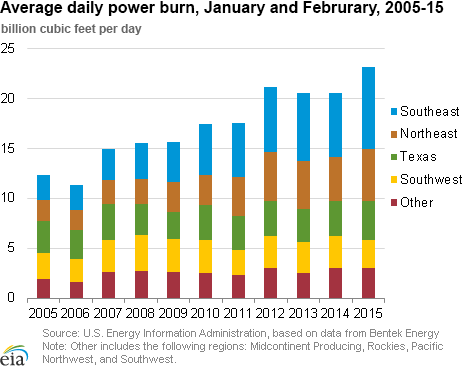
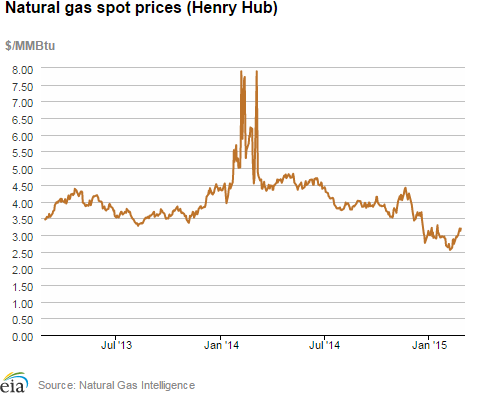
| Spot Prices ($/MMBtu) | Thu, 26-Feb |
Fri, 27-Feb |
Mon, 02-Mar |
Tue, 03-Mar |
Wed, 04-Mar |
|---|---|---|---|---|---|
| Henry Hub |
3.11 |
2.77 |
2.84 |
2.93 |
3.26 |
| New York |
16.04 |
3.45 |
4.49 |
3.82 |
15.83 |
| Chicago |
3.97 |
2.84 |
3.06 |
4.32 |
4.98 |
| Cal. Comp. Avg,* |
2.93 |
2.68 |
2.82 |
2.87 |
2.90 |
| Futures ($/MMBtu) | |||||
| April contract |
2.697 |
2.734 |
2.698 |
2.712 |
2.769 |
| May contract |
2.737 |
2.771 |
2.739 |
2.751 |
2.806 |
| *Avg. of NGI's reported prices for: Malin, PG&E citygate, and Southern California Border Avg. | |||||
| Source: NGI's Daily Gas Price Index | |||||
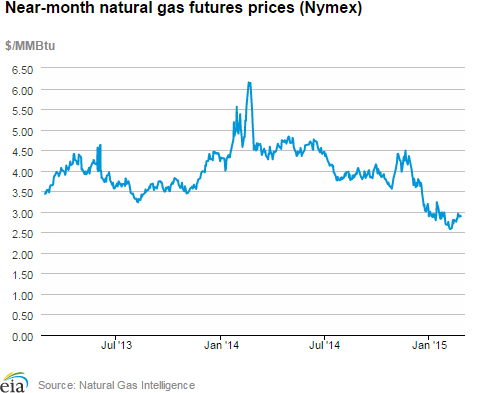
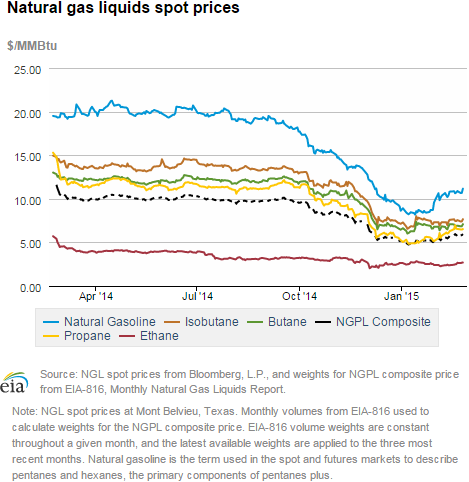
| U.S. natural gas supply - Gas Week: (2/25/15 - 3/4/15) | ||
|---|---|---|
Percent change for week compared with: |
||
last year |
last week |
|
| Gross production | 8.35%
|
-0.42%
|
| Dry production | 8.27%
|
-0.41%
|
| Canadian imports | 6.14%
|
-5.72%
|
| West (net) | 92.29%
|
7.99%
|
| Midwest (net) | -56.23%
|
-18.34%
|
| Northeast (net) | 31.17%
|
-18.24%
|
| LNG imports | 97.14%
|
-41.35%
|
| Total supply | 8.44%
|
-1.28%
|
| Source: BENTEK Energy LLC | ||
| U.S. consumption - Gas Week: (2/25/15 - 3/4/15) | ||
|---|---|---|
Percent change for week compared with: |
||
last year |
last week |
|
| U.S. consumption | -0.5%
|
-7.3%
|
| Power | 7.8%
|
-3.7%
|
| Industrial | -0.3%
|
-1.8%
|
| Residential/commercial | -3.7%
|
-10.9%
|
| Total demand | 0.1%
|
-7.2%
|
| Source: BENTEK Energy LLC | ||
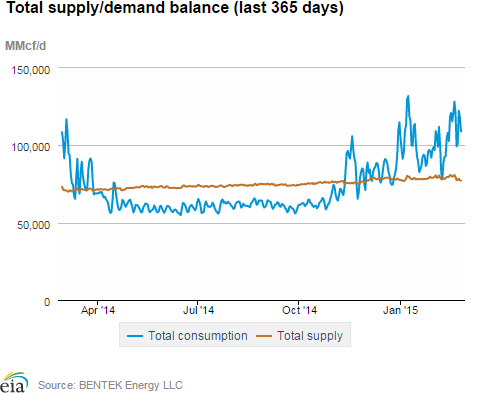
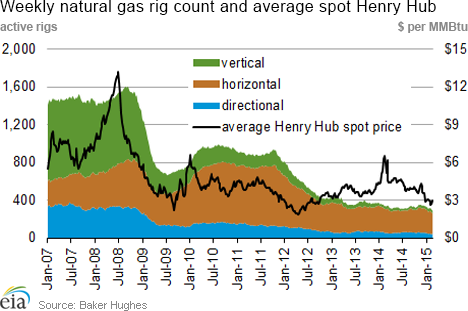
| Rigs | |||
|---|---|---|---|
Fri, February 27, 2015 |
Change from |
||
last week |
last year |
||
| Oil rigs | 986 |
-3.24% |
-31.05% |
| Natural gas rigs | 280 |
-3.11% |
-16.42% |
| Miscellaneous | 1 |
-50.00% |
-75.00% |
| Rig numbers by type | |||
|---|---|---|---|
Fri, February 27, 2015 |
Change from |
||
last week |
last year |
||
| Vertical | 194 |
-4.43% |
-50.38% |
| Horizontal | 946 |
-3.37% |
-19.90% |
| Directional | 127 |
-0.78% |
-35.53% |
| Source: Baker Hughes Inc. | |||
| Working gas in underground storage | ||||
|---|---|---|---|---|
Stocks billion cubic feet (bcf) |
||||
| Region | 2015-02-27 |
2015-02-20 |
change |
|
| East | 722 |
843 |
-121 |
|
| West | 355 |
371 |
-16 |
|
| Producing | 633 |
724 |
-91 |
|
| Total | 1,710 |
1,938 |
-228 |
|
| Source: U.S. Energy Information Administration | ||||
| Working gas in underground storage | |||||
|---|---|---|---|---|---|
Historical comparisons |
|||||
Year ago (2/27/14) |
5-year average (2010-2014) |
||||
| Region | Stocks (Bcf) |
% change |
Stocks (Bcf) |
% change |
|
| East | 537 |
34.5 |
854 |
-15.5 |
|
| West | 194 |
83.0 |
286 |
24.1 |
|
| Producing | 487 |
30.0 |
713 |
-11.2 |
|
| Total | 1,218 |
40.4 |
1,853 |
-7.7 |
|
| Source: U.S. Energy Information Administration | |||||
| Temperature -- heating & cooling degree days (week ending Feb 26) | ||||||||
|---|---|---|---|---|---|---|---|---|
HDD deviation from: |
CDD deviation from: |
|||||||
| Region | HDD Current |
normal |
last year |
CDD Current |
normal |
last year |
||
| New England | 340
|
95
|
109
|
0
|
0
|
0
|
||
| Middle Atlantic | 337
|
105
|
113
|
0
|
0
|
0
|
||
| E N Central | 371
|
123
|
99
|
0
|
0
|
0
|
||
| W N Central | 341
|
92
|
43
|
0
|
0
|
0
|
||
| South Atlantic | 227
|
80
|
110
|
7
|
-1
|
-7
|
||
| E S Central | 233
|
90
|
106
|
0
|
-2
|
-1
|
||
| W S Central | 152
|
59
|
74
|
2
|
-2
|
-4
|
||
| Mountain | 210
|
23
|
42
|
0
|
-1
|
-1
|
||
| Pacific | 90
|
-8
|
19
|
0
|
-1
|
0
|
||
| United States | 259
|
75
|
77
|
2
|
-1
|
-2
|
||
|
Note: HDD = heating degree-day; CDD = cooling degree-day Source: National Oceanic and Atmospheric Administration | ||||||||
Average temperature (°F)
7-Day Mean ending Feb 26, 2015
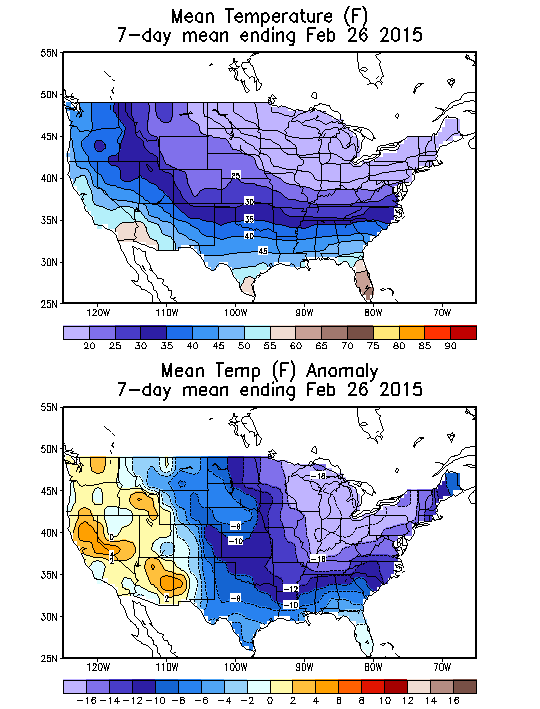
Source: NOAA/National Weather Service
Deviation between average and normal (°F)
7-Day Mean ending Feb 26, 2015

Source: NOAA/National Weather Service

